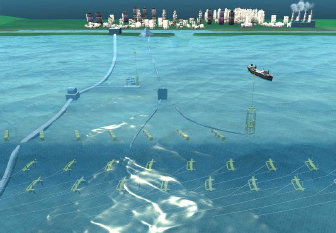University moves toward powering Florida with the Gulf Stream


Florida’s expansive coastline has long drawn surfers and sunbathers, and now, some university researchers are dipping their toes into the surf with an experiment to generate tidal power, regulators announced today.
Florida Atlantic University has applied to the Bureau of Ocean Energy Management, Regulation and Enforcement (BOEMRE) for permission to test a prototype hydrokinetic technology on the Outer Continental Shelf (OCS) approximately nine to 15 nautical miles offshore Fort Lauderdale.
“This is the first lease application BOEMRE has received to test ocean current equipment on the U.S. Outer Continental Shelf,” said BOEMRE Director Michael R. Bromwich in a prepared statement. “Before a leasing decision is made, we are preparing an environmental assessment under the National Environmental Policy Act and are providing an opportunity for public input concerning these activities.”
The assessment will consider the technology’s impact to life on the ocean floor, wildlife, and existing human uses such as commercial fishing. BOEMRE says that it has identified four other areas off of Florida for testing ocean current technology and collecting resource data.
Florida Atlantic University’s (FAC) interest lies in tapping the energy potential of the Gulf Stream, which flows continuously along the state’s eastern coast before shifting its direction toward Europe.
The turbines would utilize 23-foot-diameter rotors and generate up to 100 kilowatts of capacity, according to reports. A buoy and single anchor mooring would hold it in place.
The Gulf Stream's strong, steady current would provide baseload renewable power akin to a fossil fuel power plant. Solar and wind power sites are generally intermittent with spikes of power being generated during peak hours.
FAC has stated that Florida could meet up to a third of its energy potential by drawing on the Gulf Stream’s 8 billion gallons per minute flow rate across the OCS.
Tidal power is gaining momentum as a clean energy solution overseas: Scots are planning to power distilleries with the tides, and an undersea “kite” will is being deploy off of Northern Ireland this year to produce 500 kilowatts of electricity. Nearly 25 percent of the world’s wave and tidal technologies are located in the United Kingdom.
Domestically, the U.S. Department of Energy granted US$37 million in government grants cover 27 projects intending to generate power from rivers, tides, waves, vortexes, currents and thermal gradients.
In 2010, the DOE designated FAU the Southeast National Marine Renewable Energy Center, one of just a few national centers for ocean energy research and development. FAU's private sector partners include Verdant Power.
FAU established its program in 2006 with a grant from the state of Florida. It is also exploring the possibility of harnessing ocean thermal energy conversion.
Related on SmartPlanet:
- Undersea kites to harness tidal power
- Scots to blend whiskey with tidal power
- Tidal energy in NYC's East River
- Ocean and hydrokinetic energy get 37 million in federal funds
- How Lockheed Martin is using tropical water to create clean energy
This post was originally published on Smartplanet.com